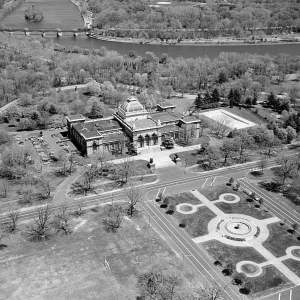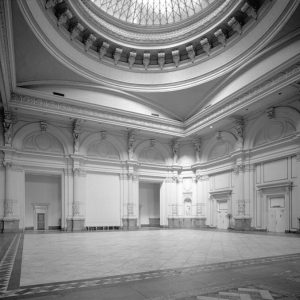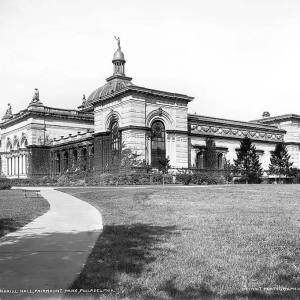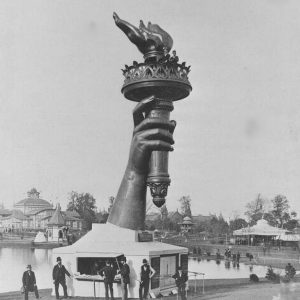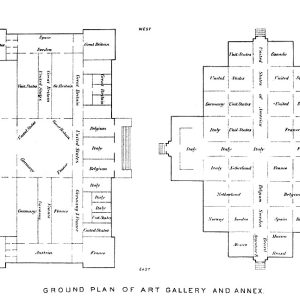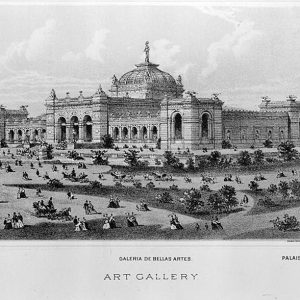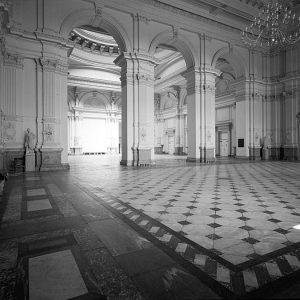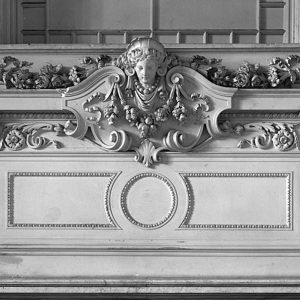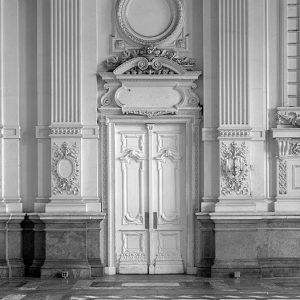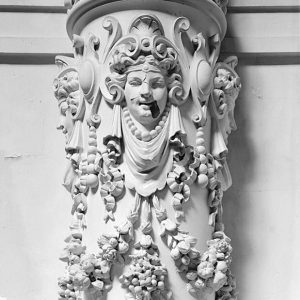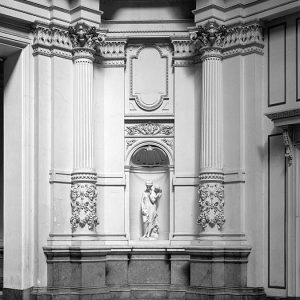Memorial Hall 1876
Memorial Hall is one of the few buildings that remain from the International Centennial Exhibition held in Fairmount Park, Philadelphia to celebrate the 100th anniversary of the United States. Architecturally, it’s an early example of a monumental building in the country and one of America’s first in the Beaux-Arts manner.
The plan of the building (the Art Museum at the centennial) consists of a main pavilion, a large central dome, and four smaller corner pavilions. The roofs are flat and balustraded. The dome is made of iron and glass. There are three arched entrances in the south (front) facade of the main pavilion.
Front corners of the main pavilion have zinc statues of Science and Art. On top of the dome is the zinc statue of Columbia, and at it’s corners are the zinc statues of Industry, Commerce, Agriculture and Mining. All of the statues were by A. J. M. Mueler of Germany. Sculptured eagle figure were originally on the corners of the smaller pavilions. The entry vestibule was originally an open arcade, which was later enclosed.((HABS PA,51-PHILA,265B- International Exposition of 1876, Memorial Hall, Belmont Avenue, Philadelphia,))
Centennial Exhibition (1876)
The Centennial Exhibition refocused attention on the West Park, drawing energy away from plans for the infrastructure of the park as a whole. As early as 1869, the Franklin Institute, the Pennsylvania Academy of the Fine Arts, and the Fairmount Park Commission hoped to hold a Centennial Exhibition in 1876 to commemorate the hundredth anniversary of the signing of the Declaration of Independence. They presented the idea to the House Committee on Manufactures and on Foreign Relations which on March 3, 1871 established a Centennial Commission and declared Philadelphia the site of the national celebration. On July 4, 1873, the Fairmount Park Commission formally transferred two hundred and thirty-six acres to the Centennial Commission, and on Independence Day the following year, ground was broken for the first Centennial building.
The fair opened on May 10, 1876, and ran through November 10 of that year with one fifth of the total U.S. population at the time passing through its gates.
Most of the exhibits were housed in five buildings: the enormous Main Building constructed of wood, iron and glass. Machinery Hall to its west, Gothic-inspired Agricultural Hall to the north, the vaguely Moorish Horticultural Hall and classical Memorial Hall.
Seventeen states constructed exhibition buildings and nine foreign governments created pavilions to house their displays. Restaurants, beer gardens and cigar pavilions further filled the site as did smaller buildings such as the Woman’s Pavilion, the Bible Pavilion and the Nevada Quartz Mill.
As “Chief Engineer of the Exhibition Grounds and Architect Permanent Buildings and Other Structures of the Centennial of Finance,” Hermann Schwarzmann played a significant role designing the fair and its buildings, building thirty-four structures including Horticultural Hall, the Women’s, Judge’s, German, and Portuguese Pavilions, and the $1.5 million Memorial Hall. Schwarzmann’s means of obtaining his commissions resembled his shrewd earlier tactics at Fairmount Park. For example, in 1873 the U.S. Centennial Commission had sponsored a competition for Memorial Hall, a permanent building designed to permanently house the city’s art collection. The winners, Collins and Autenrieth, were chosen from forty-three architects. While the Committee debated the plans, Schwarzmann, not a competition participant, prepared his own designs and somehow managed to win the commission.
Schwarzmann based his design for Memorial Hall on Nicholas Felix Escalier’s project for the Prix de Rome published in Croquis d’Architecture in 1867-69. Constructed of granite, brick, glass and iron, Memorial Hall consisted of a central domed area surrounded by four pavilions on the corners with open arcades east and west of the main entrance. During the exhibition, the building along with the Art Gallery Extension directly to its rear displayed the art of many nations.
From 1877 until 1828, Memorial Hall was used as the city’s art museum. When the new art museum was opened on the site of the Fairmount Reservoir in 1928, Memorial Hall housed the city’s less important collections. In 1954 all art was removed and the building was returned to the Fairmount Park Commission. In 1957 it was adapted as a recreation center by Hatfield, Martin, and White and [as of 1989] it functioned as office space for the Fairmount Park Commission. [Now the building is used by the Please Touch Museum.]
Of the 149 buildings constructed for the exhibition, only Memorial Hall and the Ohio House stand, and of the accompanying planned landscapes, nothing is apparent today. [Note: Two buildings next to the Horticulture Hall also remain from the centennial, now in Sakura Pavilion.]
Memorial Hall was designed as one of the Centennial Exhibition’s few permanent buildings. After serving as gallery space for the collections of many nations during the Exhibition, the building reopened on May 10, 1877, as the Pennsylvania Museum. It served as the city’s art gallery until 1928 when the main collection was moved to a new building on the site of the Fairmount Reservoir now known as the Philadelphia Museum of Art.((HABS NO. PA-6183 Fairmount Park, Along Schuylkill River, Philadelphia, Philadelphia County, PA ))
An Act Of Congress
The Act Of Creating The United States Centennial Commission An Act to provide for celebrating the One Hundredth Anniversary of American Independence, by holding an International Exhibition of Arts, Manufactures, and Products of the Soil and Mine, in the City of Philadelphia, and State of Pennsylvania in the year eighteen hundred and seventy-six. Whereas, The Declaration of Independence of the United States of America was prepared, signed, and promulgated in the year seventeen hundred and seventy- six, in the City of Philadelphia; and whereas it behooves the people of the United States to celebrate, by appropriate ceremonies, the centennial anniversary of this memorable and decisive event, which constituted the fourth day of July, Anno Domini, seventeen hundred and seventy-six,the birthday of the nation; and whereas it is deemed fitting that the completion of the first century of our national existence shall be commemorated by an exhibition of the natural resources of the country and their development, and of its progress in those arts which benefit mankind, in comparison with those of older nations; and whereas no place is so appropriate for such an exhibition as the city in which occurred the event it is designed to commemorate, and whereas as the exhibition should be a national celebration, in which the people of the whole country should participate, it should have the sanction of the Congress of the United States. ((1876, United States Centennial Commission. International Exhibition, Fairmount Park, Philadelphia))
The Commission was incorporated by an Act of Congress of 1 June 1872, which also created the incorporated Centennial Board of Finance. The grounds to be used by the International Exhibition were acquired by the City of Philadelphia as part of Fairmount Park. On 4 July 1873, a tract of approximately 450 acres overseeing the west bank of the Schuylkill River, was formally transferred to the United States Centennial Commission for use as the exhibition grounds, with great ceremonies. At the request of Congress, the President invited foreign nations to participate in the Exhibition on 5 June 1874. (Philadelphia Department of Records)
Resources
- Ferris, George Titus, 1876. Gems of the Centennial exhibition: consisting of illustrated descriptions of objects of an artistic character, in the exhibits of the United States, Great Britain, France, Spain, Italy, Germany, Belgium, Norway, Sweden, Denmark, Hungary, Russia, Japan, China, Egypt, Turkey, India, etc., etc., at the Philadelphia International Exhibition of 1876 (Google eBook)
- Party Like It’s 1876! 12 Items From the Centennial Exposition
| Please Touch Museum | Beaux-Arts Style |
|---|---|
| Memorial Hall, 4231 Avenue of the Republic | Official Website ≫ |
| National Register of Historic Places (1976), Philadelphia Register (1978) | Open Wednesday–Sunnday, 9 AM to 4:30 PM |
